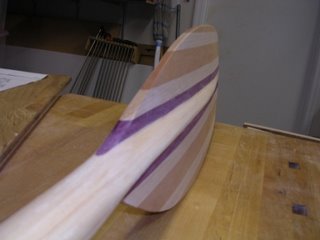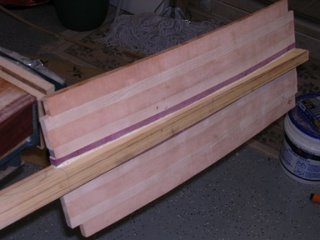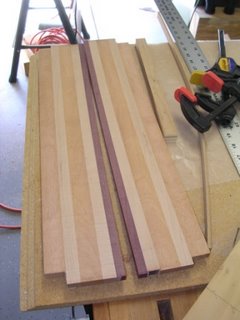
So here is the rough paddle. Everything is glued up, now all that remains is shaping the paddle and finishing it. The picture gives a good look at the feathering of the shaft.
Here, I am begining to turn the square shaft into a round one. Actually, the shafts will end up slightly oval. Before cutting the scarfs, I marked two lines on each face. The process is to knock off the corners down to these lines to make an octogon. You then knock of those corners to make 16 facets...and so on. Eventually, you get to a point where you can easily finish the rounding with sand paper.
To eliminate all the funky-ness near the scarfs, it is necessary to reduce the diameter a little more than the rest of the shaft. This is hardly noticable and shouldn't affect the performance of the paddle.
You can also see the beginning of the paddle shaping. The back ridge is pretty much formed. The bottom picture shows the blending a little better. This shaping was done with a right angle grinder fitted with a 36 grit conical attachment that you can pick up in the abrasives section of most of the big name stores. 
Shaping is a scary process. Slow and easy is the only way to approach it. The different wood species react very differently to the sanding. The purple heart and maple can take a little while to get through, but the mahogony is extremely fragile. It was a learning experience to try to cut the hard wood aggressively while not butchering the softer mahogony. But if I can do it, anyone can. Eventually, I gained quite a bit of confidence in what I was doing and was able to go pretty quick without damage.
After using the RA grinder, I did some final blending with a ROS and 50 and 80 grit paper. Also, I cut the outline to shape using the offsets in Nick's book.
 Here is a picture of my first "war wound". Let's just say exfoliating with 36 grit sand paper at 1700 rpm is not a great idea.
Here is a picture of my first "war wound". Let's just say exfoliating with 36 grit sand paper at 1700 rpm is not a great idea.


















